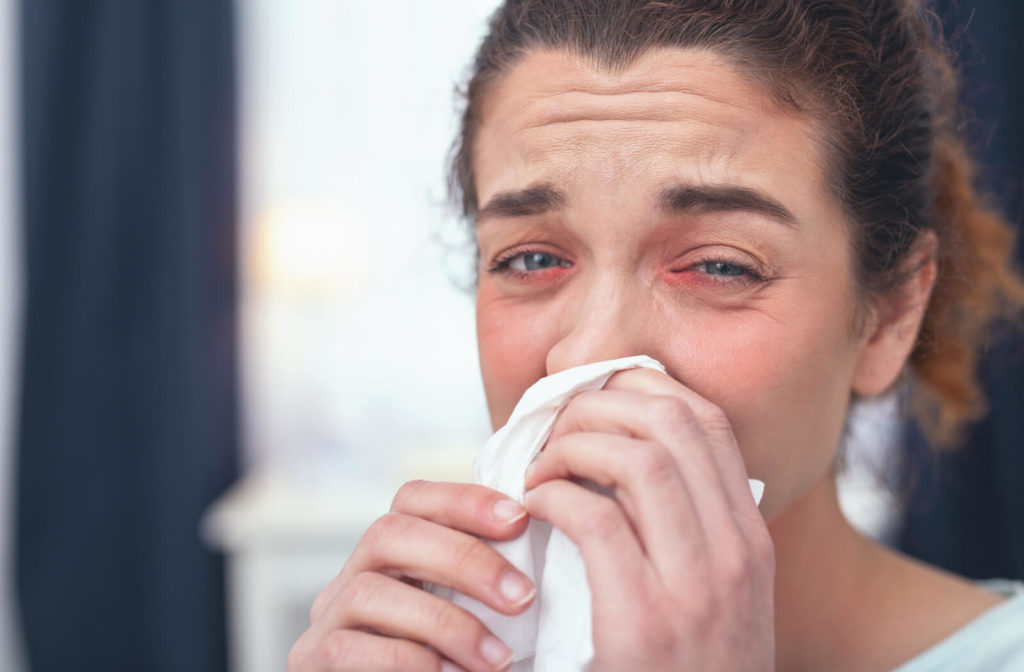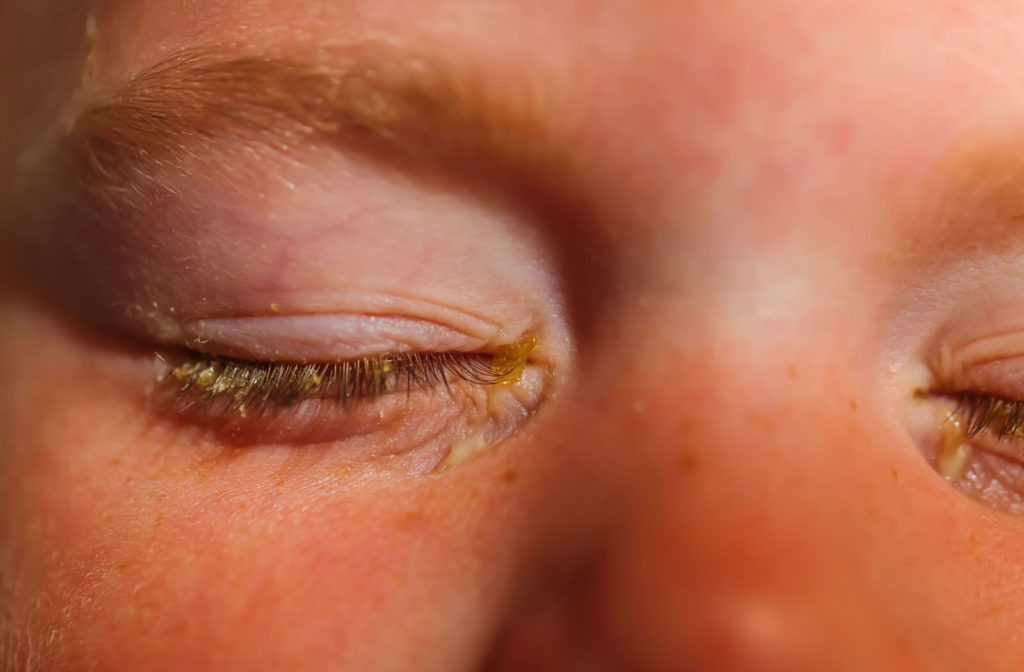It’s important to see your eye doctor every 1 to 2 years, depending on your age and eye health. But between these exams, new things can come up with your eyes or vision. It’s important to know when to seek your eye doctor’s help and when lubricating eye drops may be all your eyes need.
Pink eye is a prevalent eye infection in American adults and children. But not every case of pink eye is caused by infection, so it’s important to recognize the difference in symptoms, such as hay fever-like symptoms often accompanying eye allergies or the presence of colored discharge with infectious pink eye, among other symptoms, which we’ll explore in more detail below.
Regardless of which type of pink eye you’re affected by, treatment usually revolves around relieving symptoms, except for cases where your optometrist recommends an antiviral or antibiotic. There are also a few options for at-home relief if your symptoms are mild.
What Is Pink Eye?
Pink eye is also known as conjunctivitis due to its effect on the thin membrane on your eyelid and eyeball called the conjunctiva. Inflammation causes the blood vessels in this membrane to appear pinkish or red, thus the name “pink eye.”
Many people assume that this condition is automatically infectious. While it can have a viral or bacterial cause, that’s not always true. Allergens from the environment around you are a common source of pink eye. The symptoms vary between each cause.
The cause of pink eye isn’t always apparent. You won’t necessarily know when germs have entered your eye. There might be some external clues if it was an environmental allergen. Still, aside from seeing the eye doctor, the symptoms of your pink eye will typically provide answers on what you’re dealing with.
Pink eye isn’t a condition that typically affects your vision. Still, knowing the differences is important and can signal when to see your optometrist.

Eye Allergy
Many people experience some form of eye allergy throughout the year. Some are seasonal occurrences, while others are allergic reactions to things like dust and mold year-round. For moderate and severe cases, this results in the uncomfortable and sometimes unsightly symptoms of pink eye.
Symptoms of allergic pink eye may include:
- Intense irritation in your eyes
- Pink or red eyes
- Watery discharge from your eyes
- A gritty feeling
- Puffy eyes in the morning
Infectious Pink Eye
A virus or bacteria is likely responsible for pink eye if an allergen isn’t the culprit. Like allergic conjunctivitis, the infectious pink eye won’t typically result in serious damage to your eye or vision. But being viral or bacterial, it’s extremely contagious, and your eye doctor may recommend medication depending on the cause and severity.
Symptoms you may experience with infectious pink eye include:
- Red or pink eye (sometimes both eyes)
- Itchy, irritated feeling in your eyes
- A yellow or green discharge from eyes that sometimes causes them to stick shut in the morning
- Light sensitivity
- Excessive tearing
Key Differences Between Pink Eye and Allergies
When determining whether or not your eye irritation is caused by pink eye or allergies, so factors to consider include:
- Type of Discharge—with pink eye you may notice a thick, sticky discharge (especially with bacterial), whereas with allergies you can expect clear, watery discharge.
- Sensitivity to Light—sensitivity is more common and intense in pink eye than with allergies
- Timing and Duration—pink eye can last 1–2 weeks, regardless of exposure to allergens and allergy symptoms appear when exposed to triggers (pollen, dust) and persist as long as the exposure continues.
- Itching and Irritation—itching can occur with pink eye but is usually less prominent than in allergies
- Other Symptoms—allergies may be accompanied by sneezing, nasal congestion, or asthma and pink eye may accompany a cold or respiratory infection but is more focused on the eyes.
Treating Pink Eye
If your eye doctor determines that your pink eye is bacterial or viral, they may prescribe an antiviral or antibiotic if necessary. But other than these 2 prescription treatments, most pink eye treatments largely revolve around keeping your eyes clean and relieving symptoms—then your body can do its job and fight the infection.
Artificial Tears
Dry eye disease isn’t the only eye condition that lubricating eye drops can help with. Regardless of what causes the condition, uncomfortable symptoms like irritation or feeling like something is in your eye can often be relieved by artificial tears.
Clean Your Eyelids
Because there will likely be some discharge from your eye, keeping your eyelids and surrounding area clean is important. Additionally, applying a warm compress throughout the day can help relieve some of the irritation.
Clean or Replaces Contact Lenses
If you wear contacts, one of the first things your eye doctor will likely recommend is to stop wearing contact lenses until the pink eye treatment is finished. If you have hard contact lenses, disinfecting them overnight with a suitable solution is typically adequate.
Your optometrist will likely recommend you throw away any soft contact lenses you wore while your eye was infected. Additionally, you should ask your optometrist whether you should replace any makeup or facial products you use near your eyes.
When to See Your Eye Doctor
There’s no reason to panic if you wake up with red eyes. Eye drops are often enough to relieve your discomfort and clear up any redness. If the redness is accompanied by pain or blurriness that doesn’t improve when the eye is cleaned, or the condition worsens over time or doesn’t improve, you should see your optometrist right away.
Give us a call at Total Vision La Mesa if you’re concerned about your eyes or vision, and for preventative, routine eye exams. Our team can answer your questions and advise you on the next steps.



